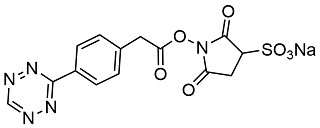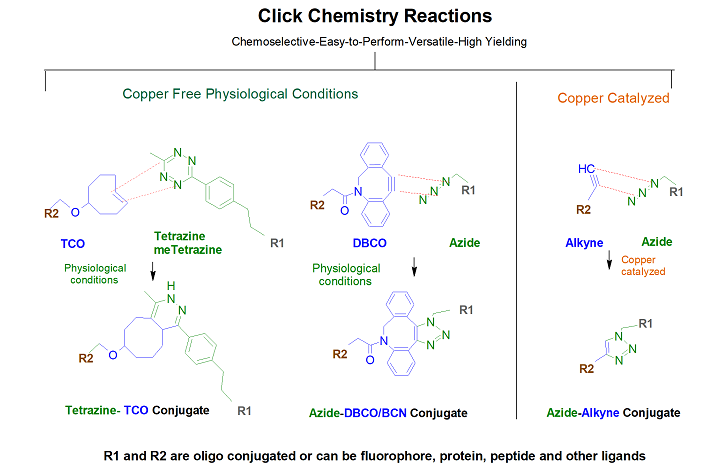
Modification : Tetrazine-Sulfo-NHS
Catalog Reference Number
Category
Modification Code
5 Prime
3 Prime
Internal
Molecular Weight (mw)
Extinction Coeficient (ec)
Technical Info (pdf)
Absorbance MAX
Emission MAX
Absorbance EC
26-6747
Click Chemistry
[Tz-Sulfo-N]
Y
Y
Y
300.93
-
PS26-6747.pdf
-
-
-
| Catalog No | Scale | Price |
| 26-6747-05 | 50 nmol | $308.00 |
| 26-6747-02 | 200 nmol | $308.00 |
| 26-6747-01 | 1 umol | $394.00 |
| 26-6747-03 | 2 umol | $513.00 |
| 26-6747-06 | 5 umol | $1,773.00 |
| 26-6747-10 | 10 umol | $1,348.00 |
| 26-6747-15 | 15 umol | $1,685.00 |
All NHS modifications are post synthesis conjugation to a primary amino group thus an additional modification with an amino group is required. A C3, C6 or C12 amino group can be placed at the 5' or for the 3' end a C3 or C7 amino and for internal positions an amino modified base is used, e.g Amino dT C6.
YIELD
NHS based modifications yields are lower as compared to direct automated coupling of modifications that are available as amidites. Approximate yield for various scales are given below.
~2 nmol final yield for 50 nmol scale synthesis.
~5 nmol final yield for 200 nmol scale synthesis.
~16 nmol final yield for 1 umol scale synthesis.
Click here for a complete list of Click Chemistry Oligo Modifications
Tetrazines are even more reactive than triazines toward nucleophiles and electron-rich dienophiles. This makes them attractive for click chemistry and they find application as conjugation tags for materials chemistry and, especially, for bio-orthogonal chemistry. In other applications they are attractive for high-energy materials, coordinating ligands, and as potent bioactive compounds.
The tetrazine will react with strained alkenes such as trans-cyclooctene, norbornene and cyclopropene to yield a stable dihydropyridazine linkage. The extremely fast kinetics and selectivity enables the conjugation of two low abundance biopolymers in an aqueous and otherwise complex chemical environment. This bioorthogonal reaction possesses excellent selectivity and biocompatibility such that the complimentary partners can react with each other within richly functionalized biological systems, in some cases, living organisms. Thus, tetrazine-TCO ligation has found numerous applications in fluorescent imaging, drug delivery, PET and SPECT imaging, radionuclide therapy, radiochemistry or drug target identification among several others.
Biocompatible click reaction occurs efficiently under mild buffer conditions; requires no accessory reagents such as a copper catalyst or reducing agents (e.g. DTT)
Chemoselective tetrazines and trans-cyclooctene groups do not react or interfere with other functional groups found in biological samples but conjugate to one another with high efficiency
Unprecedented kinetics inverse-electron demand Diels-Alder chemistry is the fastest bioorthogonal ligation available
Solubility easily dissolves in aqueous buffers
Methyltetrazine-PEG4-NHS Ester is one of the most stable tetrazines commercially available. In addition to stabilization provided by the electron donating methyl group, the electron donating alkoxy substituent on the aromatic ring further improves the stability of Methyltetrazine-PEG4-NHS Ester. The aqueous solubility of this reagent is substantially enhanced by a hydrophilic polyethylene glycol (PEG) spacer arm.
 References
References
1. Devaraj, N.K. and Weissleder, R. Biomedical Applications of Tetrazine Cycloadditions.
Acc Chem Res.(2011) 44: 816–827 .
- Tetrazine-Sulfo Oligo
